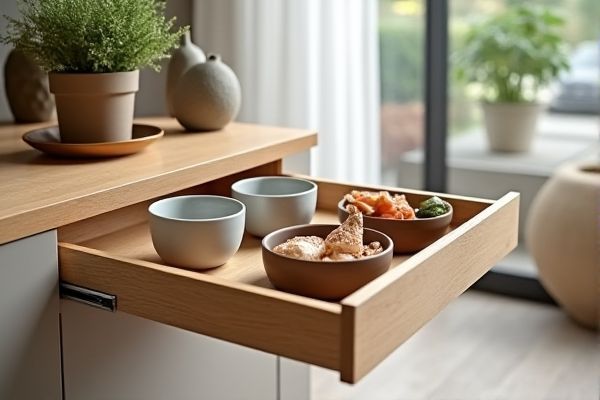
Tray dividers organize your kitchen drawers by separating utensils for easy access and tidiness, while roll-out trays maximize storage space by sliding out for convenient retrieval of items. Discover which option best suits your kitchen needs and enhances your organization by reading the rest of the article.
Table of Comparison
| Feature | Tray Divider | Roll-Out Tray |
|---|---|---|
| Purpose | Organizes items within a drawer | Provides easy access by sliding out |
| Installation | Simple, placed inside existing drawers | Requires drawer modification or special cabinet |
| Material | Wood, plastic, metal | Wood, metal, sometimes plastic |
| Accessibility | Static compartments | Fully extendable tray for easy reach |
| Cost | Generally lower cost | Higher cost due to hardware and installation |
| Use Case | Drawer organization, utensil sorting | Heavy or deep storage, improving visibility |
| Customization | Limited sizes and configurations | Often customizable to fit drawer dimensions |
Understanding Tray Dividers: Key Features
Tray dividers offer customizable compartments that help organize utensils, tools, or small items efficiently within drawers. Their adjustable design maximizes space utilization, preventing clutter and enhancing accessibility. You can easily tailor tray dividers to fit specific drawer dimensions, making them ideal for a well-organized kitchen or workspace.
Roll-Out Trays: An Overview
Roll-out trays provide easy access to the contents of cabinets by sliding out smoothly, maximizing storage efficiency in kitchens or pantries. Unlike fixed tray dividers that separate items, roll-out trays offer full visibility and convenience for organizing bulky or frequently used items. Your kitchen organization improves significantly with roll-out trays, reducing clutter and optimizing space utilization.
Space Optimization: Tray Dividers vs Roll-Out Trays
Tray dividers maximize space optimization by segmenting drawers into customizable compartments, allowing you to neatly organize smaller items without wasting room. Roll-out trays enhance accessibility and utilize deep cabinet spaces efficiently by pulling out entire trays, reducing clutter and improving visibility. Both solutions improve storage, but tray dividers focus on internal compartmentalization while roll-out trays optimize retrieval and spacious use in larger cabinets.
Installation Process Compared
Tray dividers offer a simple installation process, typically requiring minimal tools and mounting inside existing drawers to easily segment space. Roll-out trays involve a more complex installation, often requiring precise measurements, track alignment, and secure fastening to enable smooth extension and retraction. Choosing between the two depends on the desired functionality and willingness to engage in a more intricate setup for enhanced drawer accessibility.
Accessibility and Convenience
Tray dividers enhance accessibility by keeping items organized and visible within drawers, reducing the need to rummage through clutter. Roll-out trays offer convenience through full extension, allowing easy reach of stored items at the back without bending or stretching. Both solutions improve drawer functionality, but roll-out trays provide superior access for deep or hard-to-reach spaces.
Design Versatility and Customization
Tray dividers offer modular design versatility by allowing you to easily adjust compartments to fit various items, enhancing organization within drawers or shelves. Roll-out trays provide customizable access and space utilization, as they can be tailored in size and inserted in cabinets to optimize storage retrieval. Both solutions enhance your storage setup, with tray dividers focusing on flexible compartment sizes and roll-out trays emphasizing accessibility and adaptability in cabinet design.
Maintenance and Cleaning Ease
Tray dividers require minimal maintenance, typically involving simple wiping with a damp cloth to keep compartments clean and organized. Roll-out trays often have additional moving parts and tracks, which may accumulate dust and crumbs, necessitating more frequent and thorough cleaning to ensure smooth operation. Both options benefit from non-abrasive cleaners, but roll-out trays demand extra attention to maintain the sliding mechanism's functionality over time.
Cost Considerations: Which Is More Affordable?
Tray dividers typically cost less than roll-out trays due to their simpler design and easier installation. Roll-out trays often require more durable materials and sliding mechanisms, increasing both initial purchase and maintenance expenses. You should weigh your budget constraints against long-term convenience when deciding which option is more affordable for your space.
Best Applications for Each Solution
Tray dividers excel in organizing flatware, utensils, and small kitchen tools within drawers, ensuring easy access and maximum separation. Roll-out trays are ideal for deep or lower cabinets, allowing users to pull out entire trays fully for easy visibility and access to pots, pans, and pantry items. Both solutions optimize kitchen storage but cater to distinct needs: tray dividers for compartmentalized drawer organization and roll-out trays for maximizing space in hard-to-reach cabinet depths.
Choosing the Right Option for Your Kitchen Needs
Tray dividers provide a fixed, segmented organization ideal for separating baking sheets and cutting boards vertically, maximizing cabinet space for kitchens with limited drawer depth. Roll-out trays offer easy access and full visibility by sliding out smoothly, making them perfect for deeper cabinets or lower shelves where reaching items is difficult. Selecting between a tray divider and a roll-out tray depends on your cabinet configuration and frequently used kitchen tools, ensuring efficient storage tailored to your cooking habits.
 homyna.com
homyna.com